B
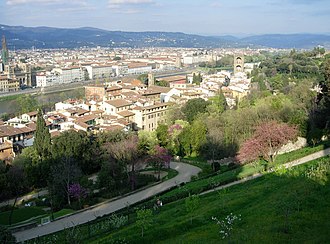
This is a list of gardens in Italy. The Italian garden is stylistically based on symmetry, axial geometry and on the principle of imposing order over nature. It influenced the history of gardening, especially French gardens and English gardens. The Italian garden was influenced by Roman gardens and Italian Renaissance gardens.


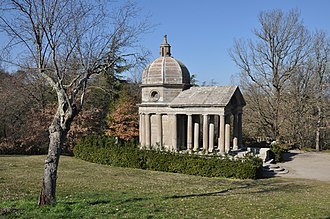
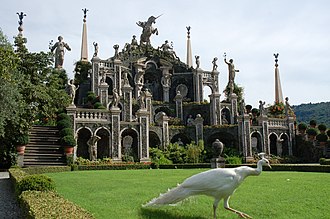

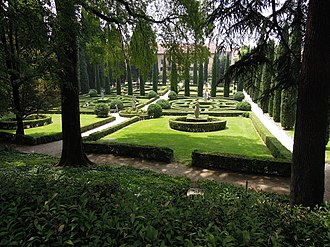
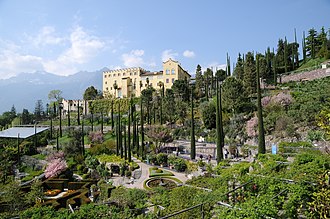
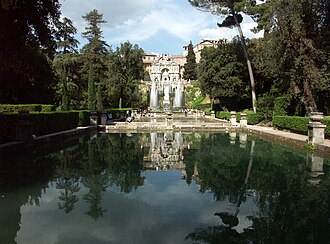
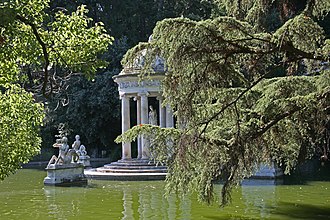
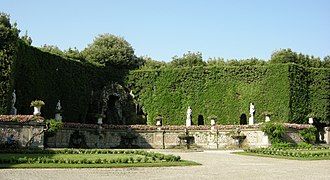

The Boboli Gardens is a historical park of the city of Florence that was opened to the public in 1766. Originally designed for the Medici, it represents one of the first and most important examples of the Italian garden, which later served as inspiration for many European courts. The large green area is a real open-air museum with statues of various styles and periods, ancient and Renaissance that are distributed throughout the garden. It also has large fountains and caves, among them the splendid Buontalenti grotto built by the artist, architect, and sculptor Bernardo Buontalenti between 1536 and 1608.

Sabbioneta is a town and comune in the province of Mantua, Lombardy region, Northern Italy. It is situated about 30 kilometres (19 mi) north of Parma, not far from the northern bank of the Po River. It was inscribed in the World Heritage List in 2008.

Isola del Liri is an Italian town of Lazio, Italy, in the province of Frosinone. As its name implies, Isola is situated between two arms of the Liri. The many waterfalls of this river and of the Fibreno are used by factories.

Palazzo Schifanoia is a Renaissance palace in Ferrara, Emilia-Romagna (Italy) built for the Este family. The name "Schifanoia" is thought to originate from "schivar la noia" meaning literally to "escape from boredom" which describes accurately the original intention of the palazzo and the other villas in close proximity where the Este court relaxed. The highlights of its decorations are the allegorical frescoes with details in tempera by or after Francesco del Cossa and Cosmè Tura, executed ca 1469–70, a unique survival of their time.

The Villa Marlia or Villa Reale di Marlia is a late-Renaissance palazzo or villa, and its estate's property that includes renowned gardens and adjacent villas and follies within the compound. It is located in Capannori, in the Province of Lucca, west of Florence, in the northern Tuscany region of Italy.

The Medici villas are a series of rural building complexes in Tuscany which were owned by members of the Medici family between the 15th century and the 17th century. The villas served several functions: they were the country palaces of the Medici, scattered over the territory that they ruled, demonstrating their power and wealth. They were also recreational resorts for the leisure and pleasure of their owners; and, more prosaically, they were the centre of agricultural activities on the surrounding estates. In 2013, the Medici villas were added to UNESCO's World Heritage list.
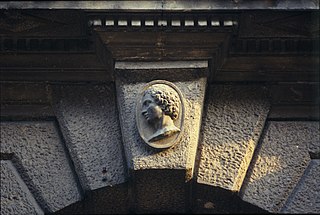
The Giusti Palace and Garden are located in the east of Verona, Italy, a short distance from Piazza Isolo and near the city centre. The palace was built in the sixteenth century. The garden is considered one of the finest examples of an Italian garden.

The following is an alphabetical list of articles related to Italy.

The flora of Italy is all the plant life present in the territory of the Italian Republic. The flora of Italy was traditionally estimated to comprise about 5,500 vascular plant species. However, as of 2019, 7,672 species are recorded in the second edition of the flora of Italy and in its digital archives Digital flora of Italy. In particular, 7,031 are autochthonous and 641 are non native species widely naturalized since more than three decades. Additionally, further 468 exotic species have been recorded as adventitious or naturalized in more recent times.

The Italian Renaissance garden was a new style of garden which emerged in the late 15th century at villas in Rome and Florence, inspired by classical ideals of order and beauty, and intended for the pleasure of the view of the garden and the landscape beyond, for contemplation, and for the enjoyment of the sights, sounds and smells of the garden itself.

The Royal Palace of Portici is a former royal palace in Portici, Southeast of Naples along the coast, in the region of Campania, Italy. Today it is the home of the Orto Botanico di Portici, a botanical garden operated by the University of Naples Federico II. These gardens were once part of the large royal estate that included an English garden, a zoo and formal parterres.

The Italian garden (or giardino all'italiana is best known for a number of large Italian Renaissance gardens which have survived in something like their original form. In the history of gardening, during the Renaissance, Italy had the most advanced and admired gardens in Europe, which greatly influenced other countries, especially the French formal garden and Dutch gardens and, mostly through these, gardens in Britain.
Antonio Perazzi is an Italian garden designer, landscape architect, botanist, writer and journalist. He is an expert in naturalistic and ecological garden.

Villa La Magia is a Medici villa in the comune of Quarrata, in the province of Pistoia, to the west of Florence, in Tuscany in central Italy. It was built by the Panciatichi family in the fourteenth century, and was bought by Francesco I de' Medici in 1583 or 1584. It has been owned by the comune of Quarrata since 2000, and since 2013 has been one of the fourteen sites which together make up a UNESCO World Heritage Site, the Medici Villas and Gardens in Tuscany.

The Palazzo del Giardino or Palazzo Ducale del Giardino is a historic palace in the Parco Ducale in Parma. It is not to be confused with the official Parma residence of Marie Louise, Duchess of Parma between Palazzo della Pilotta and Palazzo della Provincia in what is now known as piazzale della Pace - she also lived at the Ducal Palace of Colorno and in the Casino dei Boschi in Sala Baganza. The main Ducal Palace in Parma, the Palazzo della Pilotta and the teatro Reinach were all destroyed in bombing on 13 May 1944.